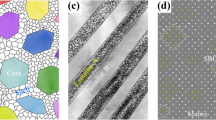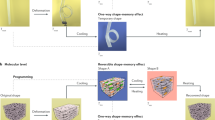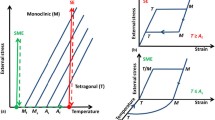Abstract
The shape memory and superelastic effects are based on mechanically or thermally induced martensitic transformation. In bulk monolithic shape memory materials, these effects are characterized by a driving force threshold, such as a critical stress or a critical temperature, above which the transformation is completed within a relatively narrow window of stress or temperature. In this viewpoint article, we discuss the tuning of macroscopic martensitic transformation characteristics via mesostructure and microstructure design: with heterogeneous driving force and low nucleation barrier in meso-/micro-structured shape memory materials, especially shape memory ceramics, local transformation events can occur sequentially rather than simultaneously. This can lead to a globally continuous transformation mode without well-defined critical stress or temperature. Based on the insights from mechanics modeling and experimental evidence, we illustrate this effect in granular packings, metal matrix composites, and cellular architectures, and discuss how it may unlock new possibilities for applications involving actuation and energy dissipation.







Similar content being viewed by others
References
Yu HZ, Hassani-Gangaraj M, Du ZH, Gan CL, Schuh CA (2017) Granular shape memory ceramic packings. Acta Mater 132:455–466. https://doi.org/10.1016/j.actamat.2017.04.057
Chowdhury P, Patriarca L, Ren G, Sehitoglu H (2016) Molecular dynamics modeling of NiTi superelasticity in presence of nanoprecipitates. Int J Plast 81:152–167. https://doi.org/10.1016/j.ijplas.2016.01.011
Ogawa Y, Ando D, Sutou Y, Koike J (2016) A lightweight shape-memory magnesium alloy. Science 353(6297):368–370. https://doi.org/10.1126/science.aaf6524
Tanaka Y, Himuro Y, Kainuma R, Sutou Y, Omori T, Ishida K (2010) Ferrous polycrystalline shape-memory alloy showing huge superelasticity. Science 327(5972):1488–1490. https://doi.org/10.1126/science.1183169
Hofmann DC (2010) Shape memory bulk metallic glass composites. Science 329(5997):1294–1295. https://doi.org/10.1126/science.1193522
Xie T (2010) Tunable polymer multi-shape memory effect. Nature 464(7286):267–270. https://doi.org/10.1038/nature08863
Xie T (2011) Recent advances in polymer shape memory. Polymer 52(22):4985–5000. https://doi.org/10.1016/j.polymer.2011.08.003
Reyes-Morel PE, Cherng J-S, Chen IW (1988) Transformation plasticity of CeO2-stabilized tetragonal zirconia polycrystals: II, pseudoelasticity and shape memory effect. J Am Ceram Soc 71(8):648–657. https://doi.org/10.1111/j.1151-2916.1988.tb06383.x
Wang Y, Ren X, Otsuka K (2006) Shape memory effect and superelasticity in a strain glass alloy. Phys Rev Lett 97(22):225703. https://doi.org/10.1103/PhysRevLett.97.225703
Casalena L, Bucsek AN, Pagan DC, Hommer GM, Bigelow GS, Obstalecki M, Noebe RD, Mills MJ, Stebner AP (2018) Structure-property relationships of a high strength superelastic NiTi–1Hf alloy. Adv Eng Mater 20(9):1800046. https://doi.org/10.1002/adem.201800046
Bucsek AN, Hudish GA, Bigelow GS, Noebe RD, Stebner AP (2016) Composition, compatibility, and the functional performances of ternary NiTiX high-temperature shape memory alloys. Shape Mem Superelasticity 2(1):62–79. https://doi.org/10.1007/s40830-016-0052-5
Schaedler TA, Carter WB (2016) Architected cellular materials. Annu Rev Mater Res 46(1):187–210. https://doi.org/10.1146/annurev-matsci-070115-031624
Restrepo D, Mankame ND, Zavattieri PD (2015) Phase transforming cellular materials. Extreme Mech Lett 4:52–60. https://doi.org/10.1016/j.eml.2015.08.001
Naebe M, Shirvanimoghaddam K (2016) Functionally graded materials: a review of fabrication and properties. Appl Mater Today 5:223–245. https://doi.org/10.1016/j.apmt.2016.10.001
Ashby MF, Chapter 11—Designing Hybrid Materials, Materials Selection in Mechanical Design (4th Edition), M.F. Ashby, (Ed.), Butterworth-Heinemann, 2011, p 299–340
Kazemi H, Vaziri A, Norato JA (2018) Topology optimization of structures made of discrete geometric components with different materials. J Mech Des. https://doi.org/10.1115/14040624
Yan X, Huang X, Zha Y, Xie YM (2014) Concurrent topology optimization of structures and their composite microstructures. Comput Struct 133:103–110. https://doi.org/10.1016/j.compstruc.2013.12.001
Asadpoure A, Tootkaboni M, Guest JK (2011) Robust topology optimization of structures with uncertainties in stiffness—Application to truss structures. Comput Struct 89(11):1131–1141. https://doi.org/10.1016/j.compstruc.2010.11.004
Zhao M, Qing H, Wang Y, Liang J, Zhao M, Geng Y, Liang J, Lu B (2021) Superelastic behaviors of additively manufactured porous NiTi shape memory alloys designed with Menger sponge-like fractal structures. Mater Des 200:109448. https://doi.org/10.1016/j.matdes.2021.109448
Wang Z (2019) Recent advances in novel metallic honeycomb structure. Compos Part B 166:731–741. https://doi.org/10.1016/j.compositesb.2019.02.011
Meza LR, Das S, Greer JR (2014) Strong, lightweight, and recoverable three-dimensional ceramic nanolattices. Science 345(6202):1322–1326. https://doi.org/10.1126/science.1255908
Cui H, Hensleigh R, Yao D, Maurya D, Kumar P, Kang MG, Priya S, Zheng XR (2019) Three-dimensional printing of piezoelectric materials with designed anisotropy and directional response. Nat Mater 18(3):234–241. https://doi.org/10.1038/s41563-018-0268-1
Portela CM, Edwards BW, Veysset D, Sun Y, Nelson KA, Kochmann DM, Greer JR (2021) Supersonic impact resilience of nanoarchitected carbon. Nat Mater 20(11):1491–1497. https://doi.org/10.1038/s41563-021-01033-z
Bauer J, Meza LR, Schaedler TA, Schwaiger R, Zheng X, Valdevit L (2017) Nanolattices: an emerging class of mechanical metamaterials. Adv Mater 29(40):1701850. https://doi.org/10.1002/adma.201701850
Rauch HA, Cui H, Knight KP, Griffiths RJ, Yoder JK, Zheng X, Yu HZ (2022) Additive manufacturing of yttrium-stabilized tetragonal zirconia: progressive wall collapse, martensitic transformation, and energy dissipation in micro-honeycombs. Addit Manuf. https://doi.org/10.1016/j.addma.2022.102692
Machado G, Louche H, Alonso T, Favier D (2015) Superelastic cellular NiTi tube-based materials: Fabrication, experiments and modeling. Mater Des (1980–2015) 65:212–220. https://doi.org/10.1016/j.matdes.2014.09.007
Du Z, Zeng XM, Liu Q, Schuh CA, Gan CL (2016) Superelasticity in micro-scale shape memory ceramic particles. Acta Mater 123:255–263
Lai A, Du Z, Gan CL, Schuh CA (2013) Shape memory and superelastic ceramics at small scales. Science 341(6153):1505–1508. https://doi.org/10.1126/science.1239745
Chen Y, Schuh CA (2011) Size effects in shape memory alloy microwires. Acta Mater 59(2):537–553. https://doi.org/10.1016/j.actamat.2010.09.057
Dunand DC, Müllner P (2011) Size effects on magnetic actuation in Ni-Mn-Ga shape-memory alloys. Adv Mater 23(2):216–232. https://doi.org/10.1002/adma.201002753
Zhu J, Gao Y, Wang D, Zhang T-Y, Wang Y (2017) Taming martensitic transformation via concentration modulation at nanoscale. Acta Mater 130:196–207. https://doi.org/10.1016/j.actamat.2017.03.042
Wang D, Hou S, Wang Y, Ding X, Ren S, Ren X, Wang Y (2014) Superelasticity of slim hysteresis over a wide temperature range by nanodomains of martensite. Acta Mater 66:349–359. https://doi.org/10.1016/j.actamat.2013.11.022
Rauch HA, Yu HZ (2020) Effects of mechanical constraint on thermally induced reverse martensitic transformation in granular shape memory ceramic packings. J Appl Phys 128(24):245102. https://doi.org/10.1063/5.0035041
Rauch HA, Chen Y, An K, Yu HZ (2019) In situ investigation of stress-induced martensitic transformation in granular shape memory ceramic packings. Acta Mater 168:362–375. https://doi.org/10.1016/j.actamat.2019.02.028
Majmudar TS, Behringer RP (2005) Contact force measurements and stress-induced anisotropy in granular materials. Nature 435(7045):1079–1082. https://doi.org/10.1038/nature03805
Tordesillas A, Tobin ST, Cil M, Alshibli K, Behringer RP (2015) Network flow model of force transmission in unbonded and bonded granular media. Phys Rev E 91(6):062204. https://doi.org/10.1103/PhysRevE.91.062204
Boyd JG, Lagoudas DC (1996) A thermodynamical constitutive model for shape memory materials. Part I. The monolithic shape memory alloy. Int J Plast 12(6):805–842. https://doi.org/10.1016/S0749-6419(96)00030-7
COMSOL Structural Mechanics Module User’s Guide, 2020
Shape Memory Alloys: Modeling and Engineering Applications, D.C. Lagoudas, (Ed.), Springer, 2008
Lagoudas DC, Entchev PB (2004) Modeling of transformation-induced plasticity and its effect on the behavior of porous shape memory alloys. Part I: constitutive model for fully dense SMAs. Mech Mater 36(9):865–892. https://doi.org/10.1016/j.mechmat.2003.08.006
Lagoudas DC, Entchev PB, Popov P, Patoor E, Brinson LC, Gao XJ (2006) Shape memory alloys, Part II: Modeling of polycrystals. Mech Mater 38(5–6):430–462. https://doi.org/10.1016/j.mechmat.2005.08.003
Reyes-Morel PE, Chen I-W (1988) Transformation plasticity of CeO2-Stabilized tetragonal zirconia polycrystals: I, stress assistance and autocatalysis. J Am Ceram Soc 71(5):343–353. https://doi.org/10.1111/j.1151-2916.1988.tb05052.x
Du Z, Zeng XM, Liu Q, Lai A, Amini S, Miserez A, Schuh CA, Gan CL (2015) Size effects and shape memory properties in ZrO2 ceramic micro- and nano-pillars. Scripta Mater 101:40–43. https://doi.org/10.1016/j.scriptamat.2015.01.013
Maran S, Masters IG, Gibbons GJ (2020) Additive manufacture of 3D auxetic structures by laser powder bed fusion—Design influence on manufacturing accuracy and mechanical properties. Appl Sci. https://doi.org/10.3390/app10217738
Arghavani J, Auricchio F, Naghdabadi R, Reali A, Sohrabpour S (2010) A 3-D phenomenological constitutive model for shape memory alloys under multiaxial loadings. Int J Plast 26(7):976–991. https://doi.org/10.1016/j.ijplas.2009.12.003
Auricchio F (2001) A robust integration-algorithm for a finite-strain shape-memory-alloy superelastic model. Int J Plast 17(7):971–990. https://doi.org/10.1016/S0749-6419(00)00050-4
Auricchio F, Petrini L (2004) A three-dimensional model describing stress-temperature induced solid phase transformations: solution algorithm and boundary value problems. Int J Numer Methods Eng 61(6):807–836. https://doi.org/10.1002/nme.1086
Ahadi A, Sun Q (2014) Effects of grain size on the rate-dependent thermomechanical responses of nanostructured superelastic NiTi. Acta Mater 76(2014):186–197
Acknowledgements
The authors would like to acknowledge the support from the National Science Foundation (NSF) (No. CMMI-1853893). This work was performed in part at the Nanoscale Characterization and Fabrication Laboratory, which is supported by the Virginia Tech National Center for Earth and Environmental Nanotechnology Infrastructure (NanoEarth), a member of the National Nanotechnology Coordinated Infrastructure (NNCI), supported by NSF (ECCS 1542100 and ECCS 2025151).
Author information
Authors and Affiliations
Corresponding author
Additional information
Publisher's Note
Springer Nature remains neutral with regard to jurisdictional claims in published maps and institutional affiliations.
This article is an invited submission to Shape Memory and Superelasticity selected from presentations at the Shape Memory and Superelastic Technology Conference and Exposition (SMST2022) held May 16–20, 2022 at The Westin Carlsbad Resort, San Diego, California and has been expanded from the original presentation. The issue was organized by Dr. Srinidhi Nagaraja, G.RAU, Inc. and Dr. Ashley Bucsek, University of Michigan.
Rights and permissions
Springer Nature or its licensor (e.g. a society or other partner) holds exclusive rights to this article under a publishing agreement with the author(s) or other rightsholder(s); author self-archiving of the accepted manuscript version of this article is solely governed by the terms of such publishing agreement and applicable law.
About this article
Cite this article
Erb, D.J., Rauch, H.A., Knight, K.P. et al. Viewpoint: Tuning the Martensitic Transformation Mode in Shape Memory Ceramics via Mesostructure and Microstructure Design. Shap. Mem. Superelasticity 9, 116–126 (2023). https://doi.org/10.1007/s40830-023-00430-4
Received:
Revised:
Accepted:
Published:
Issue Date:
DOI: https://doi.org/10.1007/s40830-023-00430-4




